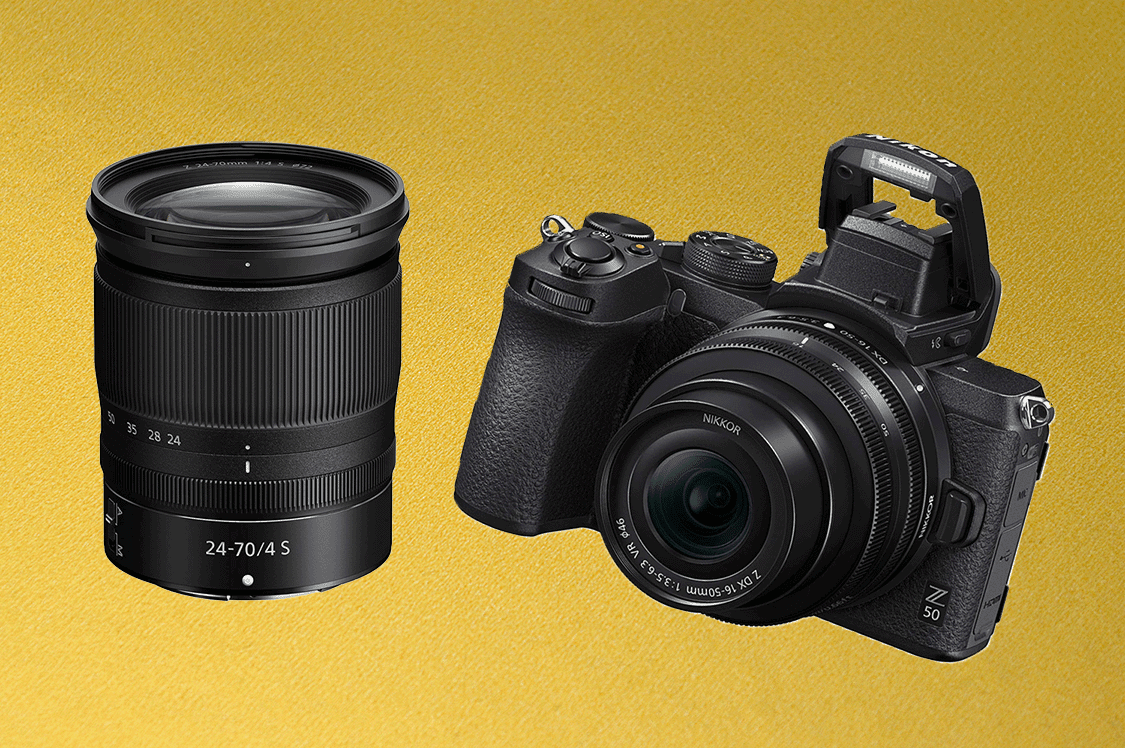While Nikon has lagged behind a bit in building their mirrorless camera and lens lineup, they’re quickly gaining ground and rectifying that.
The Nikon Z50 is an impressive little camera, and now there is a wide selection of good lenses for the Nikon Z50 to choose from.
Our pick for the best all-around lens for the Nikon Z50 is the Nikon Z 24-70mm f/4.
But, with so many good options to choose from, though, it can be difficult to decide what lenses to buy.
That’s why we’ve compiled this list of our top picks for the best lenses for the Nikon Z50. The Z50’s mount is compatible with both DX and FX lenses, which will both be included here.
Introducing the 10 Best Lenses for the Nikon Z50
So, let’s dive in, starting with our pick.
Best All-Around Lens for the Nikon Z50: Nikon Z 24-70mm f/4

The Nikon Z 24-70mm f/4 goes great with the Nikon Z50 because it has a very versatile focal range and is relatively small and lightweight, which pairs very well with the Z50’s smaller body.
With the 1.5x crop factor on the Z50’s APS-C sensor, the Nikon Z 24-70mm f/4 comes out to 36-105mm in full-frame terms. This focal range is very useful, as it covers multiple focal lengths necessary for a wide range of photography. You can use the wide end for uses such as landscape photography and architectural photography. The longer end will be great for portraits and sports. Everything in between is excellent for travel photography.
The Nikon Z 24-70mm f/4 is a very sharp lens corner to corner, even when shooting wide open. It has elements with Nikon’s Nano Crystal and Super Integrated coatings, which suppress flare and ghosting and result in higher contrast image quality.
The Nikon Z 24-70mm f/4 also has Dual Detect 5 Axis VR. VR, or vibration reduction, is what Nikon calls its image stabilization. The Nikon Z50’s VR does a great job of reducing camera shake, which means you get sharper photos, which is especially helpful in low light.
Pros:
- Very sharp image quality
- Fast and accurate autofocus
- Weather-sealed
- Small and lightweight
- Very well-controlled ghosting and flare
Cons:
- Vignetting
- Distortion
- Focus-by-wire for manual focusing
Best Prime Lens for the Nikon Z50: NIKKOR Z 24mm f/1.8 S

Nikon’s NIKKOR Z 24mm f/1.8 S is an excellent lens if you’re looking for a semi-wide-angle prime lens for your Nikon Z50. The Z 24mm f/1.8 S is a 36mm equivalent focal length on the Z50, making it great for documentary and street photography, weddings, and environmental portraits.
35mm lenses are a staple in photography for a good reason. With a 36mm-equivalent focal length, the difference between the two is negligible. This focal length is great because it’s relatively wide, but the NIKKOR Z 24mm f/1.8 S has little distortion.
The f/1.8 aperture of the NIKKOR Z 24mm f/1.8 S lets you shoot in very low light without having the extra bulk and weight of an f/1.4 lens.
The Z 24mm f/1.8 S is very sharp across the frame and produces superb color and contrast. Nikon’s f/1.8 lenses for their DSLR cameras were already very good (especially for their low price), and their Z-mount versions are even better.
Pros:
- 36mm-equivalent focal length on the Z50
- Very sharp
- Great contrast
- Well-controlled ghosting/flare
- No focus breathing
- Little to no distortion
Cons:
- Bokeh/out-of-focus areas can be distracting
- Expensive for an f/1.8 prime lens
Best Macro Lens for the Nikon Z50: NIKKOR Z MC 105mm f/2.8 VR S
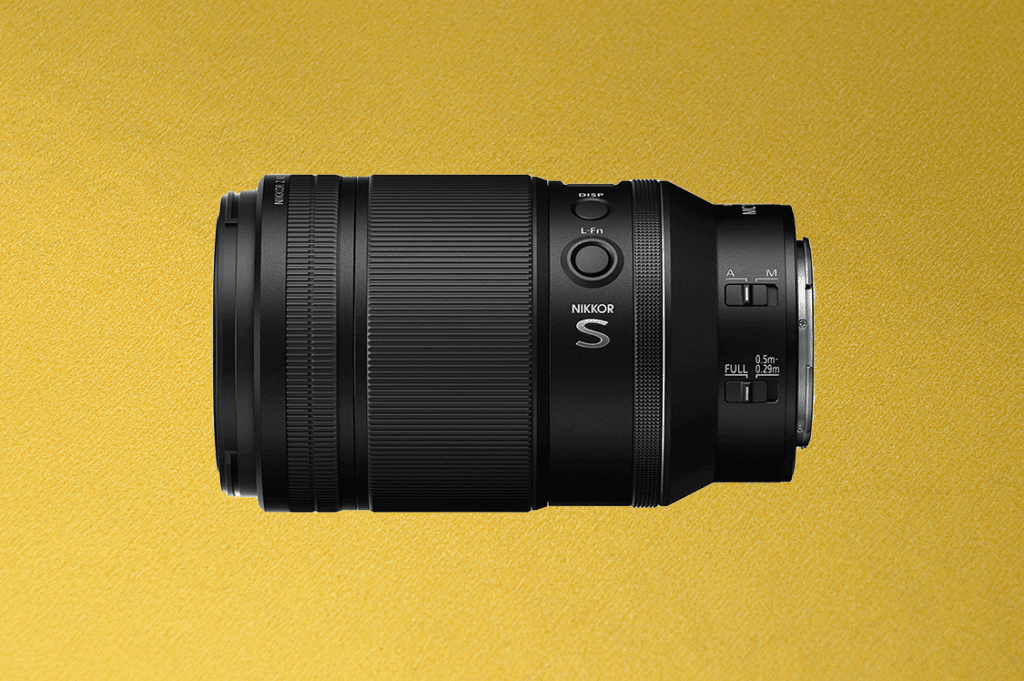
The NIKKOR Z MC 105mm f/2.8 VR S features a classic focal length for macro photography. With the 1.5x crop factor, it comes out to a 157.5mm equivalent focal length on the Z50’s APS-C-size sensor.
This lens has a true 1:1 macro reproduction ratio, which means the image projected onto the camera sensor is the same size as it is in real life. In other words, if you want to do real macro work where you can get close enough to show tiny details, a 1 to 1 macro like the NIKKOR Z MC 105mm f/2.8 VR S is necessary.
The Nikon Z MC 105mm f/2.8 resolves a ton of detail and has great clarity. In addition, lenses of this focal length have little to no distortion.
If you like getting microscopic photos of bugs or doing product photography work, it doesn’t get much better than this lens. In addition, 4.5 stops of Vibration Reduction add to this lens’ appeal, giving you more leeway for doing handheld shots with it.
This lens has fast and accurate autofocusing, which improves Nikon’s previous 105mm for DSLRs.
In addition to macro photography, the Z MC 105mm f/2.8 also doubles as a great portrait lens. The compression of this focal length is flattering for portraits.
Pros:
- Razor-sharp image quality
- True 1:1 macro capability
- Has AF/MF switch on the lens
- Has weather sealing
- Vibration reduction
- Doubles as a portrait lens
Cons:
- Electronic manual focus rather than mechanical
- Has a plastic filter thread
Alternative: The Nikon Z MC 50mm f/2.8 is another excellent option for macro photography. It also has 1:1 magnification, but the closest it can focus is 0.16m, which can be limiting. In cases where you have a small amount of space to work with, the 50mm could potentially be a better option.
Best Portrait Lens for Nikon Z50: NIKKOR Z 85mm f/1.8 S
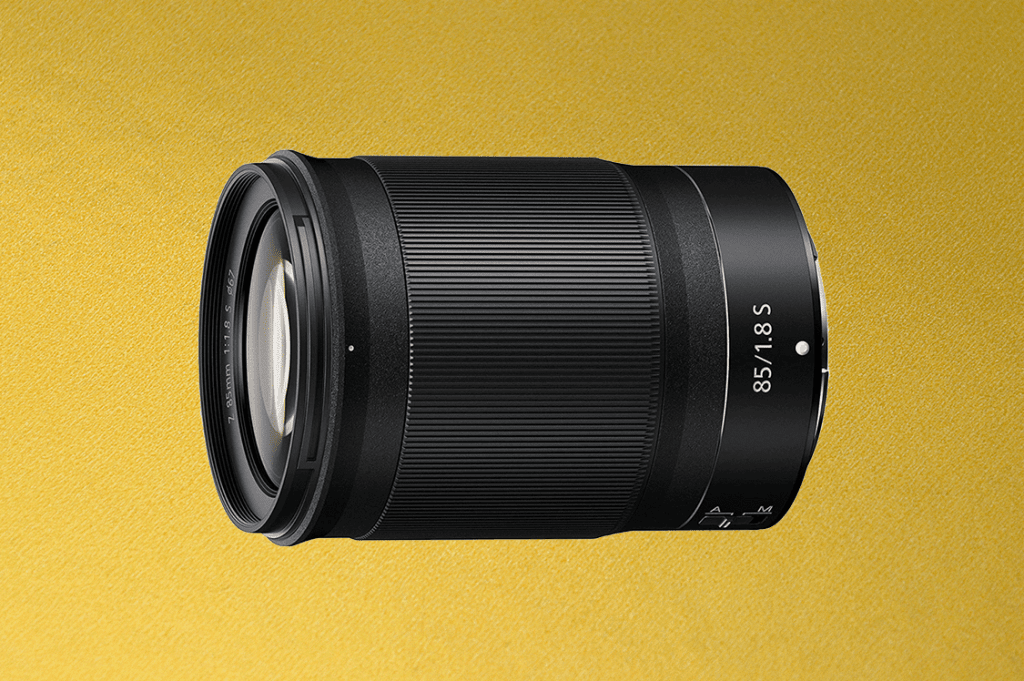
Of course, there is no perfect portrait focal length, but one of the most common is 85mm. Usually, portrait photographers shoot somewhere in the range of 50mm to 200mm.
Nikon’s NIKKOR Z 85mm f/1.8 S is an excellent portrait lens because of its focal length and image quality. Like Nikon’s other Z lenses, they did a great job in making this lens sharp across all apertures. In addition, it has excellent color reproduction with just a bit of added contrast, which looks great.
Bokeh with this lens is very soft and creamy, exactly what you’re looking for in a portrait lens.
If you like fine-tuning your focus manually, this lens has a really nice large focus ring for dialing things in more precisely.
The Z 85mm f/1.8 S comes out to a 127.5mm focal length on the Nikon Z50, making for a comfortable working distance for portraits. You’re able to talk with and direct your subjects from this focal length without having to yell. It also has nice compression for a more flattering look.
Pros:
- Great bokeh
- Excellent contrast, color, and sharpness
- Very little ghosting, flare, or chromatic aberration, even wide open
- Compact design
- Lightweight
- Fast and accurate autofocus
Cons:
- Has vignetting (fixable in post)
- Twice as expensive as Nikon’s previous 85mm f/1.8 lens for DSLRs
Best Telephoto Lens for the Nikon Z50: NIKKOR Z 70-200mm f/2.8 VR S
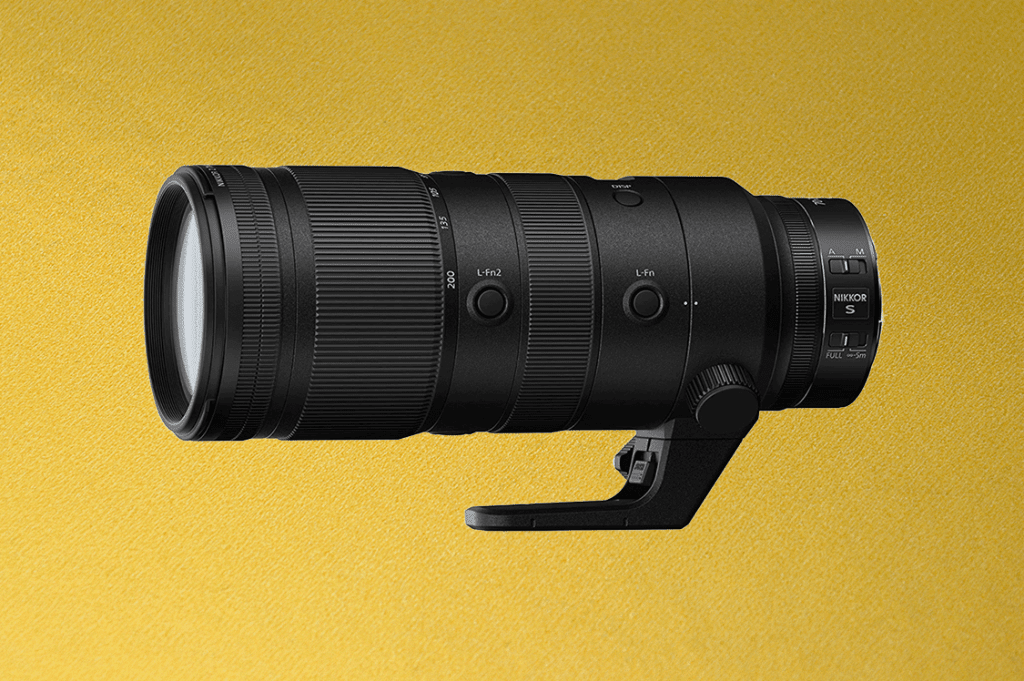
The NIKKOR Z 70-200mm f/2.8 VR S gives you a 105-300mm focal length on the Nikon Z50. That’s a lot of reach for photography that requires it, such as sports and wildlife.
The NIKKOR Z 70-200mm f/2.8 VR S is big and heavy, but they improved on the already excellent image quality of their AF-S 70-200mm f/2.8 lens for DSLRs. Also, they were able to cut the weight down by about 70 grams, which is always welcome, especially in cases where you need to carry the lens around all day.
The Nikon Z 70-200mm f/2.8 VR S is a high-performance lens with extremely snappy and accurate autofocus. It’s the type of lens you want for fast-action, and you can’t afford to miss shots. Its Vibration Reduction is a highly useful feature as well.
Pros:
- Excellent image quality
- Superb autofocus
- Constant f/2.8 aperture gives you a lot of control over depth of field/good low light performance
- Excellent image stabilization (VR)
- Rugged build quality
- Fully weather-sealed
- Great handling
Cons:
- Even though it’s lighter than previous Nikon 70-200mm lenses, it’s still big and heavy
- Expensive
- Can have “cat’s eye” bokeh
- Focus-by-wire manual focus
Best Zoom Lens for Nikon Z50: NIKKOR Z 24-120mm f/4 S
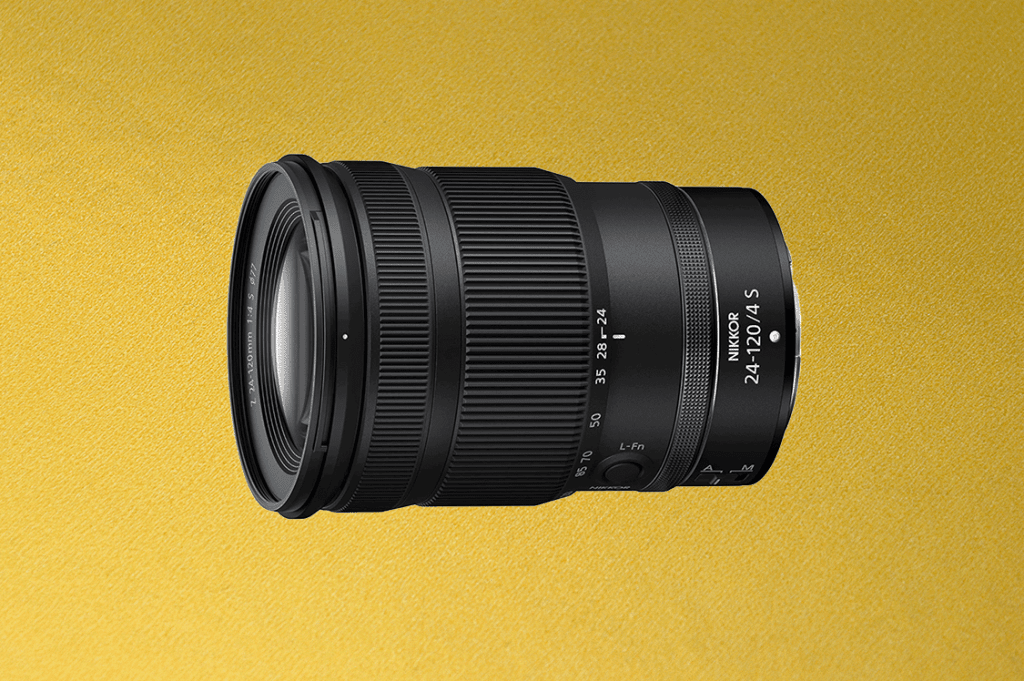
This guide wouldn’t be complete without answering the question: “what is the best Nikon zoom lens?“
When looking for a zoom lens for your Nikon Z50, you have to consider the use of the lens.
If you want a general-purpose lens with as wide a focal range as possible, the best option is the NIKKOR Z 24-120mm f/4 S. This comes out to a 36-180mm focal range on the Z50, which is a very useful focal range. You can use this lens for just about anything, from landscape to portraits.
Pros:
- Very versatile zoom range
- Close-focusing
- Weather-sealed
- Great image quality
- Close-focusing
- Compact/lightweight
Cons:
- The lens zooms externally, so the barrel sticks out pretty far when zoomed out
- A slower f/4 aperture means less control over depth of field
- Less low light capabilities compared to larger aperture lenses
Best Wide Angle Lens for the Nikon Z50: NIKKOR Z 14-30mm f/4 S
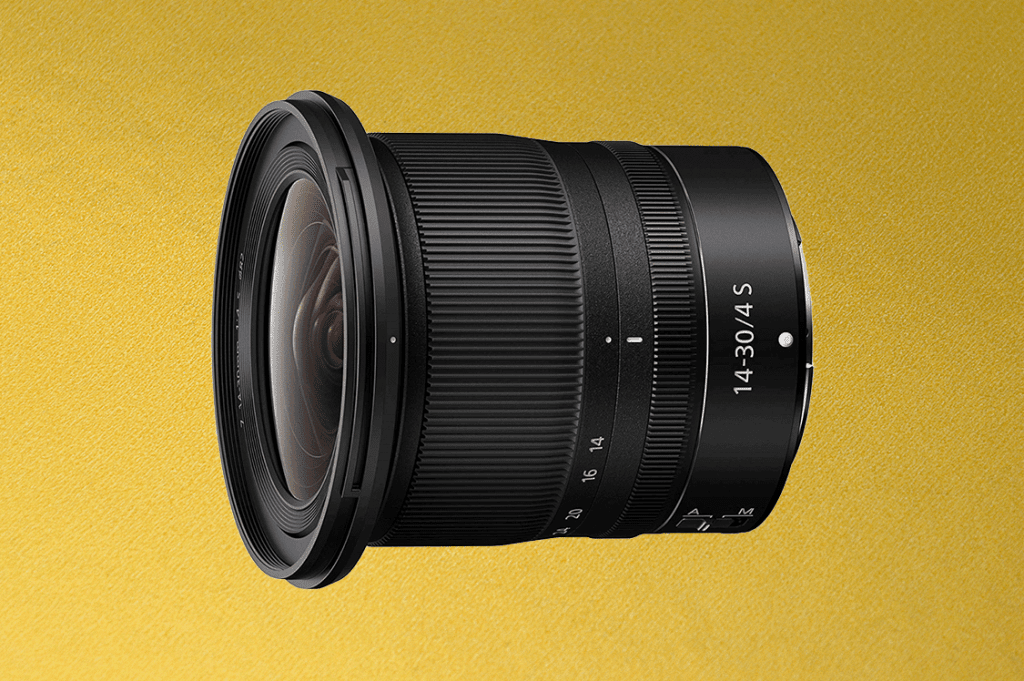
If you want to take wide-angle shots on the Nikon Z50, look to the NIKKOR Z 14-30mm f/4 S. This lens comes out to 21-45mm on the Z50, which is suited for landscape photography, real estate photography, architectural photography, and anything else where you need a wide perspective.
The NIKKOR Z 14-30mm f/4 S makes for a great combo with the Nikon Z50 because of its small size and low weight. As a result, you can carry it around for long sessions without it weighing you down too much. Plus, it doesn’t take up a lot of space in your camera bag.
Although the aperture only opens to f/4, this helps cut down on size and weight. In addition, the lens has excellent image quality.
Pros:
- Great image quality
- Compact design
- Low weight
- Very wide angle
- Sharp
Cons:
- Not as sharp in the corners
- Cheap-feeling lens hood
- Sharpness falls off in the corners
- Vignetting in corners (easily fixable in post)
- The lens has barrel distortion (but is fixed well if you edit in Lightroom or other software that supports the Nikon Z50 and this lens)
Best Wildlife Lens for Nikon Z50: NIKKOR Z 100-400mm f/4.5-5.6 VR S
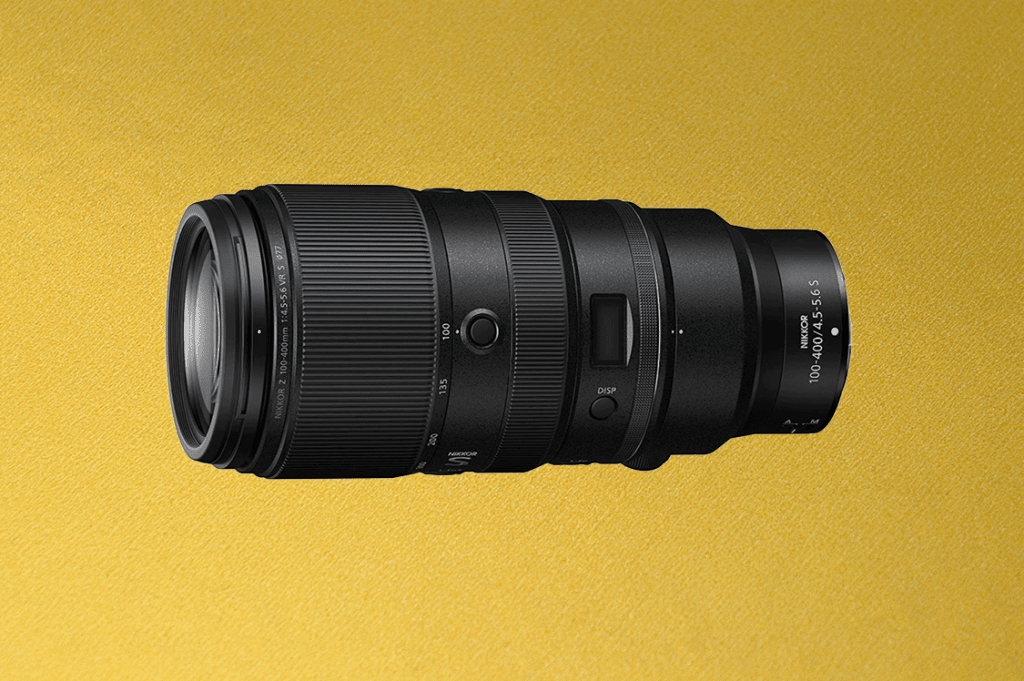
Reach is the name of the game when it comes to wildlife lenses. After all, you want to be able to photograph wildlife without disturbing their environment whenever possible.
The NIKKOR Z 100-400mm f/4.5-5.6 VR S comes out to 150-600mm for a bit extra reach than full-frame cameras. This lens has excellent image quality. It has excellent autofocus, too, so it’s particularly great for bird photography or any photography with fast-moving wildlife.
With a lens this long, image stabilization is a big deal because any lens movement while taking photos is a lot more noticeable than with wider lenses. Luckily, this lens has very good VR that allows you to shoot handheld at slower shutter speeds than you’d expect.
Lastly, it’s great that this lens has weather sealing. When you’re photographing wildlife, you can expect to be out in the elements, so it’s nice having peace of mind knowing that your lens is protected from any moisture getting into it.
For these reasons, it’s the best wildlife lens for the Nikon Z50 and the best Nikon Z lens for wildlife overall.
Pros:
- Excellent image quality
- Fast and accurate autofocus
- Has very far reach for photographing wildlife from far away (especially on the Nikon Z50’s APS-C sensor)
- Focuses almost as close as a macro lens
Cons:
- It’s big and bulky (9 inches long)
- It’s heavy (1435 grams)
- Expensive
Best Landscape Lens for The Nikon Z50
So if you’re wondering, “which Nikon Z lens is best for landscape photography?” let’s attempt to give the best possible answer here. Lenses for landscape photography may come as a surprise for photographers unfamiliar with it. Landscape photography is most associated with wide, sweeping vistas, but many landscape images are taken with long lenses.
Experienced landscape photographers usually have a wide-angle zoom and pair that with a mid-range to telephoto zoom. The wide-angle gets used more, so it is more of a workhorse. The telephoto zoom comes in whenever the wide-angle zoom doesn’t have enough reach.
For wide-angle shots, the best landscape lens for the Nikon Z50 is the NIKKOR Z 14-30mm f/4 S.
It’s really unnecessary to go wider than this, so this lens has you covered as far as landscape photography goes.
The telephoto landscape lenses are different, though. Photographers use telephoto lenses for landscape photography for various reasons. The most common reason is to zoom in on a mountain or other subject for composition reasons.
The NIKKOR Z DX 50-250mm f/4.5-6.3 VR is the best lens to pair with the NIKKOR Z 14-30mm f/4 S for landscape photography. With these two lenses, you have a compact, lightweight setup and all the necessary focal lengths covered, from wide-angle to telephoto, with just a small gap from 30-50mm.
The NIKKOR Z DX 50-250mm f/4.5-6.3 VR has excellent image quality throughout its focal range, and its VR is handy when shooting handheld, especially at the long end. Its autofocus can be a bit slow at times in low light, but that’s not an issue for landscape photography, considering you’re mostly going to use it in strong sunlight.
Best Travel Lens for the Nikon Z50: The NIKKOR Z 24-200mm f/4-6.3 VR
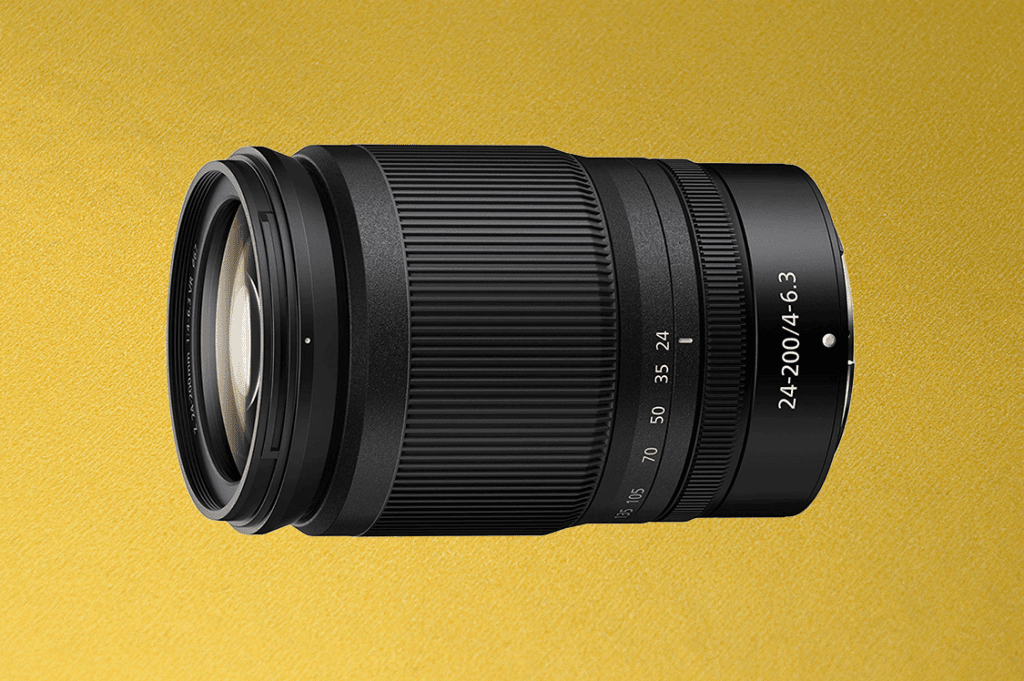
The NIKKOR Z 24-200mm f/4-6.3 VR is a veritable super zoom. While it does have a slower, variable aperture, it has an incredibly useful zoom range.
Doing photography while traveling is all about bringing the least amount of gear possible for maximum results. With a 24-200mm focal range, you have pretty much every focal range you could possibly need, which means you can pack lighter and leave your other lenses at home.
This lens is not exactly small at 4.5 inches long with the lens retracted. Still, it’s manageable, especially considering this lens reduces the need for other lenses, freeing up room in your camera bag. The f/4-6.3 variable aperture makes it not as good in low light as a large-aperture prime, but that’s a tradeoff for it having such a wide focal range.
In addition to replacing multiple lenses, the NIKKOR Z 24-200mm f/4-6.3 VR is lightweight (570 grams), particularly for its size. Similarly sized 24-70mm lenses are almost double that weight.
Image quality is outstanding and sharp, although not quite as good as what you can get with primes and small focal range zooms. Though that’s to be expected in a lens with such a wide focal range.
Pros:
- Extremely wide and useful focal range
- Good image quality
- Sharp
- Lightweight
- Fast autofocus
- Can replace several lenses so you can pack light for travel
Cons:
- Variable aperture
- Less control over depth of field
- Not the best low light performance
Best Video Lens for The Nikon Z50: NIKKOR Z 28-75mm f/2.8 VR

When Nikon released the NIKKOR Z 28-75mm f/2.8 VR, it came as a bit of a surprise considering its slightly unconventional focal range. It’s also pleasantly surprising how Nikon was able to make this lens smaller and significantly lighter than the Nikon Z 24-70mm f/2.8.
The NIKKOR Z 28-75mm f/2.8 VR has a nice focal range for video work.
A great thing about the NIKKOR Z 28-75mm f/2.8 VR for video is its image stabilization. Image stabilization can be beneficial with photography, but it’s even more critical with videography. Any camera shake is very distracting in videography and can potentially ruin footage. Of course, you can fix shaky footage in post-processing, but it’s a time-intensive process that uses a lot of CPU power, so it’s better to get it right in-camera whenever possible.
With its f/2.8 constant aperture, you’re able to work in low light, and you have more control over your depth of field. Backgrounds can be more complex to control in videography than photography, so it’s nice to blur out any distracting elements — and the lens has beautiful creamy bokeh.
Pros:
- Great image quality
- Creamy bokeh
- Versatile focal range
- VR works great to stabilize video
- Fast, smooth, and silent autofocus
- Lightweight
Cons:
- On APS-C cameras like the Z50, the 42-112.5mm focal length can be too long in tight spaces
- Primarily plastic construction and has a plastic filter thread
- Has a focus-by-wire (electronic) manual focus ring rather than mechanical
- No AF/manual focus switch
FAQ
What lens mount is the Nikon Z50?
The Nikon Z50 uses Nikon’s Z mount, the same mount they use for their full-frame mirrorless cameras. That means you can use both FX and DX lenses on the Nikon Z50. Nikon lenses with DX in their name are optimized for DX (APS-C/crop sensor) cameras like the Z50.
If you want to use older lenses made for Nikon’s DSLRs or film cameras, you’ll need an F to Z adapter.
What is the FTZ adapter, and how well does it work?

The FTZ adapter is Nikon’s adapter that lets you use their old glass on the newer Z mount for mirrorless cameras.
The FTZ adapter works very well. There’s no glass in it, so there’s no loss of image quality. It allows the camera to detect the lens, and autofocus works flawlessly, so you don’t even realize it’s there. If you’re coming from Nikon DSLRs and have a lot of F-mount glass, it’s well worth the investment. You can also find third-party options for cheaper.
Can the Nikon Z50 use DX lenses?
Yes, the best lenses for the Nikon Z50 are DX lenses, as it’s DX-format (i.e., APS-C) sensor camera. DX lenses are better optimized for the Nikon Z50, although you can also use FX Z-mount lenses with it.
On the other hand, if you want to use F-mount DX lenses on the Nikon Z50, you’ll need the F to Z adapter.
Can I use full-frame lenses on the Nikon Z50?
Yes, Nikon uses the same mount for their full-frame and crop-sensor cameras, so full-frame lenses are compatible with crop-sensor camera bodies and vice versa. Nikon refers to their full-frame cameras and lenses as FX and their crop sensor cameras and lenses as DX.
Can you use F-mount lenses on the Nikon Z50?
You can as long as you use an F to Z adapter. The F to Z adapter lets you attach F-mount lenses to Z-mount cameras. The camera can detect what lens you’re using through the mount and use autofocus and any other features the lens would have on its native mount.
Are there any Sigma Lenses for Nikon Z Mount and the Z50?
As of this writing, there are currently no Sigma lenses for Nikon Z mount cameras. However, if the rumor sites are accurate, Sigma may enter the Nikon space at some point in the near future.
There are, however, lenses for Nikon Z mount available from brands like Cosina, TTartisan, Meyer Optik Görlitz Trioplan, Tokina, Yongnuo, Venus Optics, and Viltrox.
Conclusion
As you can see, there are a lot of lenses to choose from when it comes to finding the best lens for the Nikon Z50. The perfect lens doesn’t exist, but you can determine the best lens for you and your Nikon Z50 depending on what you’re going to use the lens for. When you have that in mind, the decision becomes much easier.
So there you have it, the best lenses for the Nikon Z50. Keep in mind that gear is great, but your creative vision is more important. So, regardless of whether you have the best lens for the Nikon Z50 or not, get out there and shoot.

